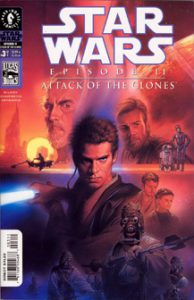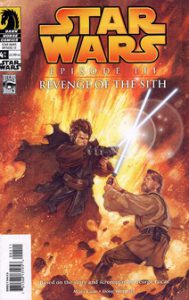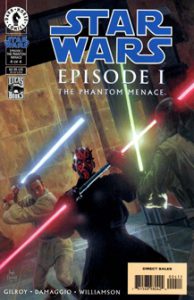I feel the “Star Wars” prequel films get a little more stagey and theatrical – or to be harsher, a little sloppier — as they go along, but the comic adaptations are the opposite: They get progressively better. “Episode I: The Phantom Menace” (1999) is a flat retelling, “Episode II: Attack of the Clones” (2002) has vibrant art but can’t overcome another bland script, and “Episode III: Revenge of the Sith” (2005) is poetic and beautiful.
Henry Gilroy would go on to be a solid writer on comics and “The Clone Wars,” but his adaptations of Episodes I and II are unimaginative, either because he was still learning or because he had tough deadlines and – having not seen the films, which were unfinished at the time — a poor grasp of what to emphasize as George Lucas introduced new eras of “Star Wars”: first Anakin’s youth and the waning glory days of the Republic, then the start of the Clone Wars.
Although I have no trouble telling which characters are which in “The Phantom Menace,” Rodolpho Damaggio’s likenesses are short on emotion. Al Williamson’s inks and Dave Nestelle’s colors help, but there’s not much energy, even in action scenes like the podrace and the Darth Maul duel. If a reader had not seen the film, they wouldn’t be able to tell precisely how Anakin wins the race or how Obi-Wan defeats Maul. John Williams’ music played in my head during the final panel of the Theed City celebration, not because it is evocative – it’s just a single, wide-angle shot — but because it so desperately needs inserts of smiling heroes and Boss Nass yelling “Peace!”

On “Attack of the Clones,” Jan Duursema – best known for the Clone Wars stories in “Republic” — delivers her usual energetic layouts by varying the size of panels and the figures and objects in them. Ray Kryssing’s inks and colors by six different contributors are as unflattering to her art as I’ve ever seen, but still, it’s Duursema, so everyone looks right and moves with purpose.
Written by Miles Lane with pencils and inks by Doug Wheatley (later known for “Dark Times”) and colors by Christopher Chuckry, “Revenge of the Sith” has no problems other than those already present in the movie script. Each panel looks like a moody painting, and this complements the Shakespearean tragedy of the story rather than working against it, as the straightforward lighting of the film does.
The artists provide emotion when it’s needed, such as Padme crying or Sidious scowling, but Lane also does his part. Whereas Gilroy translated one medium to another with narration that’s often there when it’s not needed and absent when it is needed, Lane knows when to narrate and when to let the art do the talking. For example, he writes “A short while later …” on the panel of Obi-Wan boarding Padme’s ship bound for Mustafar, as opposed to “A short while later, Obi-Wan boards Padme’s ship bound for Mustafar.”


Each adaptation is a different length, even though they were all published as four-issue series. “Episode I” is 122 pages, “Episode II” is 144 pages and “Episode III” is 96 pages. There are no bonus scenes in “Clones” such as the novelization’s scenes of Padme’s family. Rather, the story is allowed to breathe more than the other two, and Duursema is given room for more splash pages or partial splash pages. I’m guessing the short page count of “Sith” came about because there’s a tradeoff if you hire Wheatley: His art is unparalleled, but he’s notoriously slow.
“Menace” has the most differences from its film counterpart: Sebulba speaks basic and appears to be killed in the podrace; some of Jar Jar’s lines are slightly different, suggesting that George Lucas and Ahmed Best made tweaks when recording dialogue; and Anakin warns that Jar Jar will be turned into “green goo” instead of the more logical “orange goo.” “Clones” has some extended dialogue, such as librarian Jocasta Nu chatting with Obi-Wan about Count Dooku and Padme mentioning an old boyfriend to Anakin.
“Sith” has the most important additions, even if one of them is clunky: Qui-Gon communicates with Yoda just before Yoda tells Obi-Wan about this particular Force ability. “The Clone Wars” would later reveal that Yoda had trained with Qui-Gon BEFORE this scene, so Lucas apparently changed his mind on that detail. The panel of Yoda on Dagobah in the closing montage is essential, and I still can’t understand why it’s not in the film itself.
The prequel comic adaptations are a passable way to relive the films, and while it’s hard for a fan to resist having them in their collection, they are by no means essential reads.

